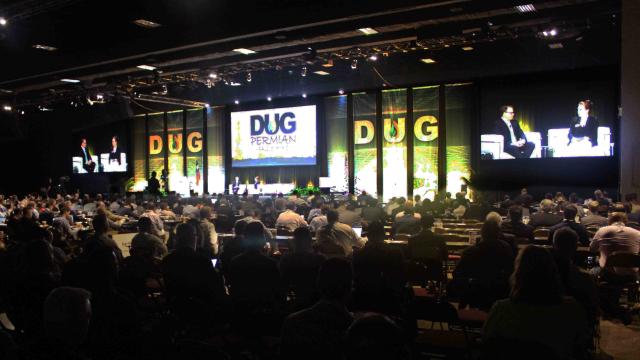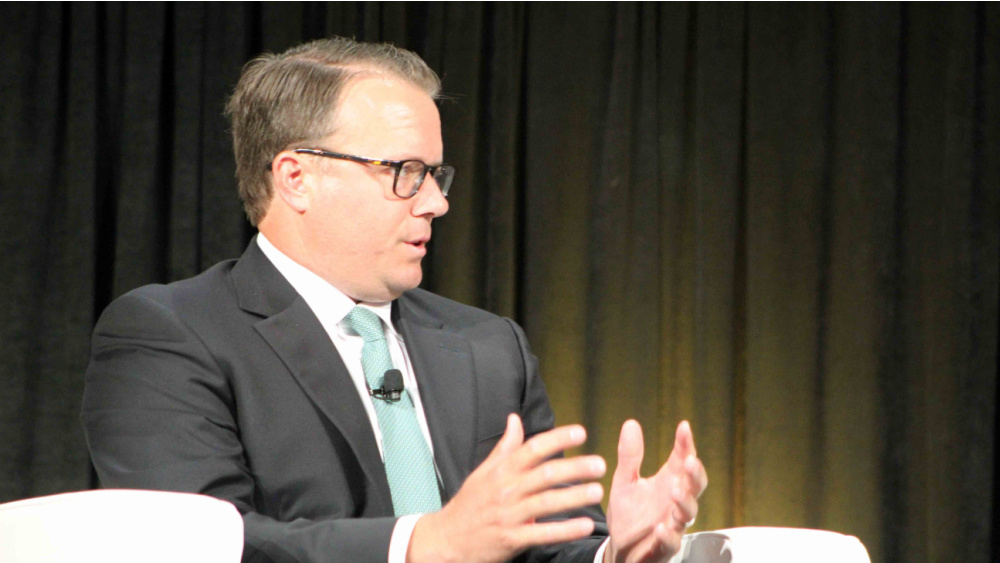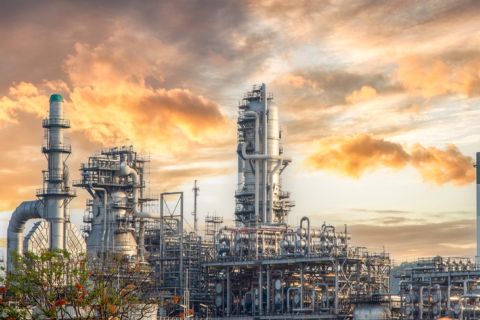
Diamondback Energy CFO Kaes Van’t Hof speaks with Hart Energy’s Nissa Darbonne on July 13 during the DUG Permian & Eagle Ford conference in Fort Worth, Texas. About 2,200 people attended the event. (Source: Joseph Markman/Hart Energy)
FORT WORTH, Texas—Getting credit where it’s due is not something the oil and gas industry receives if you ask Kaes Van’t Hof, CFO and executive vice president of business development for Diamondback Energy Inc.
“It’s very hard, difficult for me personally, to wake up every morning and see three articles about the death of your industry when you know it’s not the case,” Van’t Hof told attendees of Hart Energy’s DUG Permian and Eagle Ford conference and exhibition on July 13. “Diamondback and the industry, in general, are ready to fight this fight.”
Barrels produced in the Eagle Ford and Permian Basin are among the lowest cost and most sustainable barrels in the world, he said. “That has contributed massively to U.S. economic expansion since the global financial crisis, and it’s going to contribute over the next few years.”
The shale executive shared his thoughts as the industry continues to bounce back from a challenging year, which included a historic oil price collapse. So far in 2021, oil prices have improved by more than 40% thanks to supply cuts by OPEC and allies and rising global oil demand. However, the pressure is still on for E&Ps like Diamondback to not only show capital discipline and generate higher shareholders returns, but also improve carbon footprints and address other ESG concerns.

In the industry’s current state, public oil and gas producers will be judged by Wall Street on LOE and G&A plus their emissions profile, methane intensity and flaring, Van’t Hof said.
“That generally means as a large public company capital will flow to those that are better actors than worse. … There is a lot of work being done on the oil field’s emissions profile, and I don’t think it’ll ever get to zero,” he said. “But like we said before, this industry is going to be a leader in terms of carbon capture and sequestration, that’s for sure.”
Diamondback earlier this year said it aims to reduce its Scope 1 greenhouse gas intensity by at least 50% and its methane intensity by at least 70% from 2019 levels by 2024. The company said it flared 0.75% of its gross gas production in first-quarter 2021, a drop of more than 85% from 2019. That flared gas percentage is 1% when QEP Resources Inc., which was acquired by Diamondback this year, is added to the picture.
Addressing the emissions profile and flaring is not insurmountable, he said, but the industry must work together to get it done by ensuring midstream infrastructure and takeaway is in place.
As part of its ESG efforts, the company is also working to maximize electrification of its gas-driven engines and electrify drilling operations. Diamondback has spent millions on electrifying its fields.
“Carbon management is probably going to be solved by people in this room and by our industry,” he told a roomful of DUG attendees.
“What’s been frustrating to me, from a political perspective is the offshoring of U.S. barrels by an administration that doesn’t want us to produce oil and gas in the U.S. when a barrel produced by Diamondback, Pioneer, Conoco in the Permian Basin is the lowest carbon emission barrel in the world,” he added. “I think that logic has been lost on Washington, but I think what we need to do as an industry is continue to push our emissions profile down while producing barrels at the lowest cost and the lowest carbon footprint. And that’s what we intend to do because that’s what the shareholders want us to do.”
Van’t Hof’s also shared views on other topics during the Q&A with Hart Energy’s Nissa Darbonne, editor-at-large for Oil and Gas Investor.
Improving Recovery: The days of drilling a single well and getting excited about 24-hour IP are gone, according to Van’t Hof. The company has gotten smarter about how it develops Permian resources as it moves to what he called “true manufacturing with large pads, lower costs and really massive operations.”
Efficiency has remained at the core. This includes using simultaneous hydraulic fracturing, or simul-frac, technology that enables two horizontal wells to be stimulated at the same time using one pressure pumping fleet.
“You’re essentially completing twice the amount of lateral feet per day as a conventional frac crew. … You’re completing more lateral footage at a lower cost,” he said. “It’s kind of cost-neutral to the frac provider but we save some time on location with all the ancillary supplies that we need to frac the well.”
The improved cycle times enabled Diamondback to use fewer rigs, moving from plans to use 11 this year down to nine, also utilizing knowledge from the QEP team. It “not only improves returns on current projects but also opens up other zones that might have lower recoveries to economic development,” Van’t Hof said.
Capital Discipline: The strides are being made as oil prices continue to climb from historic lows seen in 2020. It may be tempting to ramp up activity, considering hedge losses this year have impacted free cash flow. However, Diamondback—like many of its public peers in the Permian Basin—are staying disciplined. The company plans to produce in total between 218,000 bbl/d and 222,000 bbl/d, spending between $1.6 million and $1.75 million.
“Capital discipline for the public companies is real, and that means if oil goes down $10 tomorrow, I’m going to have a pretty bad day,” said Van’t Hof. “But our plan is not going to change. So, there’s just so much space now between the oil price that keeps us cash flow neutral to generating positive free cash flow and covering the dividend.”
Consolidation: Having closed acquisitions of QEP and assets from Guidon Operating LLC during the first quarter, Diamondback has been an active player in the consolidation wave moving across shale plays. Such action will continue in the basin and the industry, he said, calling it a positive for returns and oil price.
“There’s going to be a few large basin champions in each basin—majors included,” he said. “I think generally that means if all the big guys stay disciplined and don’t grow production too much like what we’ve done in the past, then I think we’re set up for a very healthy next couple of years.”
Cautioning the industry is still a cyclical business, he added “OPEC’s done a great job managing the market and we need to do our part by staying disciplined, generating free cash and giving it back to our shareholders.”
Recommended Reading
Marathon Chasing 20%+ IRRs with Los Angeles, Galveston Refinery Upgrades
2024-02-01 - Marathon Petroleum Corp. is pursuing improvements at its Los Angeles refinery and a hydrotreater project at its Galveston Bay refinery that are each boasting internal rate returns (IRRs) of 20% or more.
Marathon Petroleum Sets 2024 Capex at $1.25 Billion
2024-01-30 - Marathon Petroleum Corp. eyes standalone capex at $1.25 billion in 2024, down 10% compared to $1.4 billion in 2023 as it focuses on cost reduction and margin enhancement projects.
Moda Midstream II Receives Financial Commitment for Next Round of Development
2024-03-20 - Kingwood, Texas-based Moda Midstream II announced on March 20 that it received an equity commitment from EnCap Flatrock Midstream.
Buffett: ‘No Interest’ in Occidental Takeover, Praises 'Hallelujah!' Shale
2024-02-27 - Berkshire Hathaway’s Warren Buffett added that the U.S. electric power situation is “ominous.”
Humble Midstream II, Quantum Capital Form Partnership for Infrastructure Projects
2024-01-30 - Humble Midstream II Partners and Quantum Capital Group’s partnership will promote a focus on energy transition infrastructure.






